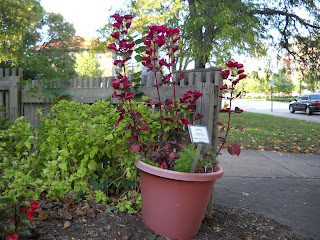
This is Japanese blood grass, a cultivar of
Imperata cylindrica. It’s on display at Purdue Horticulture Gardens, right along Marstellar St.
This red leaved variety of
Imperata cylindrica is being used for landscaping in Indiana but it has the potential to be invasive.
Imperata cylindrica has been rated as one of the ten worst weeds worldwide. The Japanese blood grass that you see around here is not supposed to spread via seed. Probably best not to plant this stuff at all, though. If you have it planted and want to get rid of it, don’t rip it out and dump it out in the woods!
As an indicator of this plant's ability to spread you might notice that it has taken over the space in the cracks between the bricks of the retaining wall.
Picture taken October 10, 2009.
Link to Imperata cylindrica:
Link to Imperata cylindrica:
Link to Imperata cylindrica “Rubra”:










 This is Lavender Cotton, Santolina chamaecyparissus 'Santa'.
This is Lavender Cotton, Santolina chamaecyparissus 'Santa'.
















